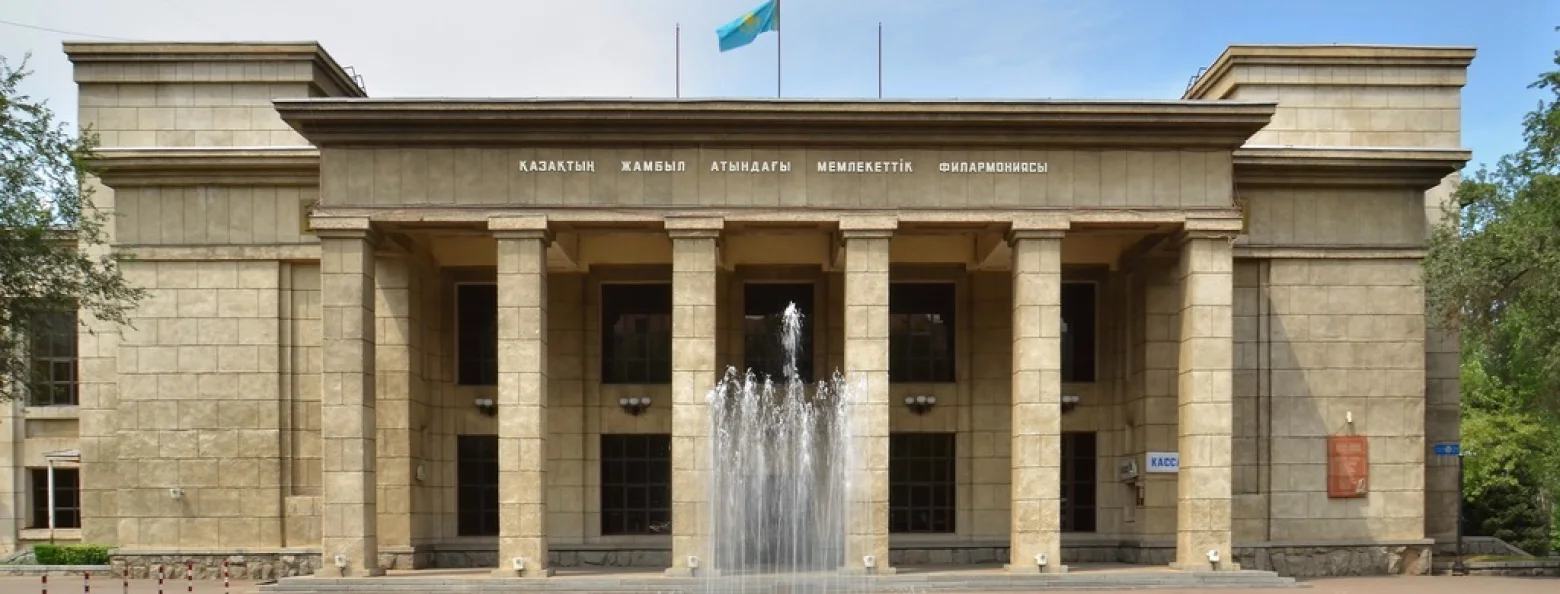About the Philharmonic

The cradle of the national musical art – the Kazakh State Philharmonic named after Zhambyl was established in 1935. During the formation of the republics of the Soviet Union and in particular Kazakhstan, great attention was paid to the support of musical culture and art. The creation of national art collectives, educational and concert activities was strongly supported, which quite logically led to the creation of the Kazakh State Philharmonic Society on January 14, 1935 by the resolution of the Council of People’s Commissars of the Kazakh SSR.Zhambyl in the capital of the republic of Alma-Ata.
The first director and artistic director of the Philharmonic was Akhmet Zhubanov, an outstanding musicologist, composer, conductor, People’s Artist of the Kazakh SSR, academician of the Academy of Sciences of the Kazakh SSR, public and statesman, author of remarkable monographs on Kazakh folk music – “Strings of Centuries” and “Nightingales of Centuries”. After A.Zhubanov, the Philharmonic was headed by representatives of culture, among whom were outstanding musicians who, with their creative work, contributed to the further development and flourishing of the creative organization. Their names have entered the history of Kazakh musical art: E.Brusilovsky, A.Kaplambekov, M.Koishibaev, S.Mukhamedzhanov, E.Rakhmadiev, B.Amangeldiev, M.Bestybaev, T.Ibraev, A.Dautbaev, T.Alpiev, M.Uteuov, K.Urazgaliev.
Initially, the Philharmonic united within its walls an ensemble of dombrists consisting of 14 musicians, a choir and a large group of soloists. The soloists of the Philharmonic were famous artists who brought fame and entered the history of Kazakh culture – Dina Nurpeisova, Nausha Bukeikhanov, Kali Zhantleuov, Ohap Kabigozhin, Lukpan Mukhitov, Rustembek Omarov, Uriya Turdykulova, Garifola Kurmangaliev, Kosymzhan Babakov, brothers Rishad and Muslim Abdullins.
The promotion of traditional music and the music of Kazakhstani composers is the main principle of the music policy, which the Philharmonic has been preserving for 87 years of its existence. In order to expand the repertoire policy with works of world classics and folk-professional music, new artistic collectives are being formed in the Philharmonic – symphonic, brass, chamber, folklore and ethnographic orchestras, choral chapel, string quartet, woodwind quintet.
Truly masters of their craft worked in these creative collectives. Their names are widely known and they are the pride of Kazakh professional music. These are Nurgisa Tlendiev, Fuat Mansurov, Ermek Serkebayev, Bibigul Tulegenova, Magauiya Khamzin, Shamgon Kazgaliyev, Anatoly Molodov, Nurgali Nusipzhan, Anatoly Kelberg, Yuri Klushkin, Timur Mynbayev, Temir Tkishev, Karshymbai Akhmediyarov, Tulepbergen Abdrashev, Ayman Musakhodzhayeva, Gulzhamilya Kadyrbekova, Zhania Aubakirova, Gauhar Myrzabekova, Galiya Moldakarimova, Beimbet Demeuov, Gabit Nesipbayev, Aida Ayupova, Zhanar Suleymanova and many others. Thanks to their selfless work, the Kazakh national performing school was created, which is widely known outside our country. Today, performers and art collectives of the Kazakh State Philharmonic named afterZhambyl perform in the most prestigious concert halls of the world – is this not a real proof of the competitiveness of our artists!
The Philharmonic Music Lecture Hall has been working regularly since the early 50s, and its main task was to promote folk, classical and modern music. All collectives and soloists of the Philharmonic participated in this educational work.
The Philharmonic played a big role in promoting the bright original creations of Russian composers, who made an invaluable contribution to the development of the musical art of the republic with their creativity. The Philharmonic stage presents different genres – from folk music, which is performed on folk instruments to large symphonic forms. Today they are the decoration of the treasury of Kazakh musical art. The repertoire of philharmonic collectives and soloists includes performances of traditional composers – Abai, Birzhan Sal, Zhayau Musa, Dauletkerei, Kurmangazy, Ikhlas, Mukhit, Baluan Sholak, Ahan-Sere, Kazangap, Sugir and works by Kazakhstani composers who made up the color of Kazakh professional music – Mukan Tulebayev, Akhmet Zhubanov, Evgeny Brusilovsky, Latif Hamidi, Kapan Musin, Ablahat Espayev, Bakhytzhan Baykadamov, Sydykh Mukhamedzhanov, Nurgisa Tlendiev, Kuddus Kozhamyarov, Makalim Koishibayev, Gaziza Zhubanova, Yerkegali Rakhmadiev, Anatoly Bychkov, Georgy Grizbil, Bazarbai Zhumaniyazov, Mansur Sagatov, Kenzhebek Kumysbekov, Bakir Bayakhunov, Mynzhasar Mangitayev, Temirzhan Bazarbayeva, Shamshi Kaldayakov, Asset Beiseuova, Eskendir Khasangalieva, Tles Kazgalieva, Zholan Dustenov, Almas Serkebayev, Kenes Duisekeyev, Tulegen Mukhamedzhanov, Zholaman Tursunbayev, Balnur Kydyrbek, Almabeka Meirbekov, Bakhtiyar Amanzholov, Serik Yerkimbekov, Beybut Daldenbayev, Artyk Toksanbayev, Kuat Shildebayev, Aktoty Raimkulova, Alibi Mambetov, Serik and Alibi Abdinurov, etc.
